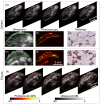Tomographic Ultrasound and LED-Based Photoacoustic System for Preclinical Imaging
- PMID: 32422995
- PMCID: PMC7294432
- DOI: 10.3390/s20102793
Tomographic Ultrasound and LED-Based Photoacoustic System for Preclinical Imaging
Abstract
Small animals are widely used as disease models in medical research. Noninvasive imaging modalities with functional capability play an important role in studying the disease state and treatment progress. Photoacoustics, being a noninvasive and functional modality, has the potential for small-animal imaging. However, the conventional photoacoustic tomographic systems use pulsed lasers, making it expensive, bulky, and require long acquisition time. In this work, we propose the use of photoacoustic and ultrasound tomographic imaging with LEDs as the light source and acoustic detection using a linear transducer array. We have demonstrated full-view tomographic imaging of a euthanized mouse and a potential application in liver fibrosis research.
Keywords: fibrosis; liver; photoacoustic; small animal; tomography; ultrasound.
Conflict of interest statement
The authors declare no conflicts of interest.
Figures



Similar articles
-
A prototype hand-held tri-modal instrument for in vivo ultrasound, photoacoustic, and fluorescence imaging.Rev Sci Instrum. 2015 Mar;86(3):034901. doi: 10.1063/1.4915146. Rev Sci Instrum. 2015. PMID: 25832265
-
Towards Clinical Translation of LED-Based Photoacoustic Imaging: A Review.Sensors (Basel). 2020 Apr 27;20(9):2484. doi: 10.3390/s20092484. Sensors (Basel). 2020. PMID: 32349414 Free PMC article. Review.
-
Tomographic imaging with an ultrasound and LED-based photoacoustic system.Biomed Opt Express. 2020 Mar 23;11(4):2152-2165. doi: 10.1364/BOE.384548. eCollection 2020 Apr 1. Biomed Opt Express. 2020. PMID: 32341873 Free PMC article.
-
Handheld probe integrating laser diode and ultrasound transducer array for ultrasound/photoacoustic dual modality imaging.Opt Express. 2014 Oct 20;22(21):26365-74. doi: 10.1364/OE.22.026365. Opt Express. 2014. PMID: 25401669
-
Simultaneous photoacoustic and ultrasound imaging: A review.Ultrasonics. 2024 Apr;139:107277. doi: 10.1016/j.ultras.2024.107277. Epub 2024 Feb 28. Ultrasonics. 2024. PMID: 38460216 Review.
Cited by
-
Design and characterization of color printed polyurethane films as biomedical phantom layers.Biomed Opt Express. 2023 Aug 7;14(9):4485-4506. doi: 10.1364/BOE.491695. eCollection 2023 Sep 1. Biomed Opt Express. 2023. PMID: 37791261 Free PMC article.
-
Deep-Learning-Based Algorithm for the Removal of Electromagnetic Interference Noise in Photoacoustic Endoscopic Image Processing.Sensors (Basel). 2022 May 23;22(10):3961. doi: 10.3390/s22103961. Sensors (Basel). 2022. PMID: 35632370 Free PMC article.
-
Oxygen Saturation Imaging Using LED-Based Photoacoustic System.Sensors (Basel). 2021 Jan 4;21(1):283. doi: 10.3390/s21010283. Sensors (Basel). 2021. PMID: 33406653 Free PMC article.
-
Portable and Affordable Light Source-Based Photoacoustic Tomography.Sensors (Basel). 2020 Oct 29;20(21):6173. doi: 10.3390/s20216173. Sensors (Basel). 2020. PMID: 33138296 Free PMC article. Review.
-
U-Net enhanced real-time LED-based photoacoustic imaging.J Biophotonics. 2024 Jun;17(6):e202300465. doi: 10.1002/jbio.202300465. Epub 2024 Apr 15. J Biophotonics. 2024. PMID: 38622811 Free PMC article.
References
-
- Li L., Zhu L., Ma C., Lin L., Yao J., Wang L., Maslov K., Zhang R., Chen W., Shi J., et al. Single-impulse panoramic photoacoustic computed tomography of small-animal whole-body dynamics at high spatiotemporal resolution. Nat. Biomed. Eng. 2017;1:1–11. doi: 10.1038/s41551-017-0071. - DOI - PMC - PubMed
MeSH terms
Grants and funding
LinkOut - more resources
Full Text Sources

